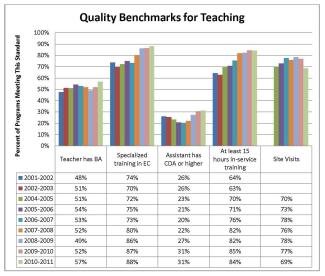
Learning about Teaching
What We Know about Early Ed Professionals
May 8, 2012
Our 2011 State Preschool Yearbook got a lot of attention for sounding the alarm on decreasing per-child funding threatening program quality. Nothing is more important for providing a high-quality early education than highly effective teachers and assistant teachers. NIEER’s research-based quality standards benchmarks credit teacher requirements in five different ways:
· Lead teachers must have a bachelor’s degree or equivalent;
· Lead teachers must have specialized training in early childhood education;
· Assistant teachers must have a Child Development Associate (CDA) credential or equivalent;
· Lead teachers must receive at least 15 clock hours per year (or 6 credit hours per 5 years) of professional development; and,
· Regular site visits are conducted to monitor program implementation.
Of the 39 states offering state-funded pre-K in the 2010-2011 year, only eight states (plus the Louisiana NSECD program) met all five of these benchmarks for lead and assistant teachers. A related issue is teacher pay, which is on average much lower in preschools than in elementary schools. Although 19 states required all lead teachers to have a BA with specialized training, a mere 7 states had this requirement and pay them comparably to kindergarten teacher salary as of 2009-2010.
As can be seen in the graph below, the percent of programs meeting each teacher qualification benchmark has certainly increased over time, though some more so than others. For example, the increase in programs requiring at least 15 hours per year of professional development—from 64 percent to 84 percent—indicates a growing understanding that continued support for teachers is necessary beyond just initial training. The growth in requiring lead teachers to have a BA has been comparatively slow, but is especially laudable considering the economic difficulties of the last decade and the fact that more advanced teacher degrees likely drive up the program costs.

Where programs still consistently fall short is in the qualifications required of assistant teachers—only 26 percent of programs required assistant teachers to have a CDA in 2001-2002, which increased to only 31 percent of programs in 2010-2011. Only two programs exceeded the benchmark by requiring an AA for assistant teachers in all settings of their preschool programs (i.e., nonpublic and public), while at least four programs had no formal educational requirements for their assistant teachers. It is clear that the focus over the last decade has been strengthening lead teacher requirements, perhaps out of the assumption that these teachers have the bulk of the interaction with children. However, considering that most programs require an assistant teacher in order to meet the 1:10 staff-to-child ratio we look for, assistant teachers have a clear presence in the early childhood classroom. If preschool programs are truly to have effective team teaching, states must provide adequate pay, supports and training for assistant teachers to ensure all staff interactions with children are of high-quality and developmentally appropriate.
The question of how to ensure we have great teachers in pre-K classrooms is not only for program administrators to answer; teacher preparation programs need to step up. A recent study from the Center for the Study of Child Care Employment explored higher education programs that prepare early childhood education teachers. As noted by Laura Bornfreund of the New America Foundation, diversity across states makes good data hard to come by:
“…[E]arly childhood preparation programs vary greatly for a few reasons. States lack common education and licensing standards for teachers of children, birth to 5. Some states don’t require student teaching at all. At the institution level, preparation programs are often housed in different departments. Some may be based in the School of Education but often they are located elsewhere, such as Family and Consumer Science Departments, for example. And when early childhood preparation programs say that they are including infants and toddlers in their scope, they may primarily address K-3.”
In educational settings, diversity is a wonderful thing—there’s hardly a loftier educational goal than students and staff from different backgrounds working and learning together. But the current diversity in the requirements and quality of teacher preparation programs has nothing to do with ensuring that the teaching force is diverse and produces a cacophony of bureaucracy and lack of standardization in preparation that serves neither teachers nor students well.
All this comes on the heels of a Government Accountability Office report on the early child care and education (ECCE) workforce that found the 1.8 million employees in pre-K, child care, and Head Start are still faced with low levels of education and compensation. The report found that preschool teachers, who were the highest paid among these professionals, still only made about $18,000 per year (excluding pre-K teachers in elementary schools). Data from the American Communities Survey indicated that 72 percent of these workers lacked an associate’s degree or higher. Clearly, the preparation, support, and compensation of today’s early childhood workforce is out of sync with what we know is best to provide our children with a high-quality early education. Despite these challenges, ECCE teaching staff do the best they can for our children, understanding that, as Garrison Keillor said, “Nothing you do for children is ever wasted. They seem not to notice us, hovering, averting our eyes, and they seldom offer thanks, but what we do for them is never wasted.”
So to the 1.8 million ECCE teachers out there—thanks on behalf of the millions of young children you serve everyday!
– Megan Carolan, Policy Research Coordinator, NIEER
– Steve Barnett, Director, NIEER
The Authors
W. Steven (Steve) Barnett is a Board of Governors Professor and the founder and Senior Co-Director of the National Institute for Early Education Research (NIEER) at Rutgers University. Dr. Barnett’s work primarily focuses on public policies regarding early childhood education, child care, and child development.
About NIEER
The National Institute for Early Education Research (NIEER) at the Graduate School of Education, Rutgers University, New Brunswick, NJ, conducts and disseminates independent research and analysis to inform early childhood education policy.

